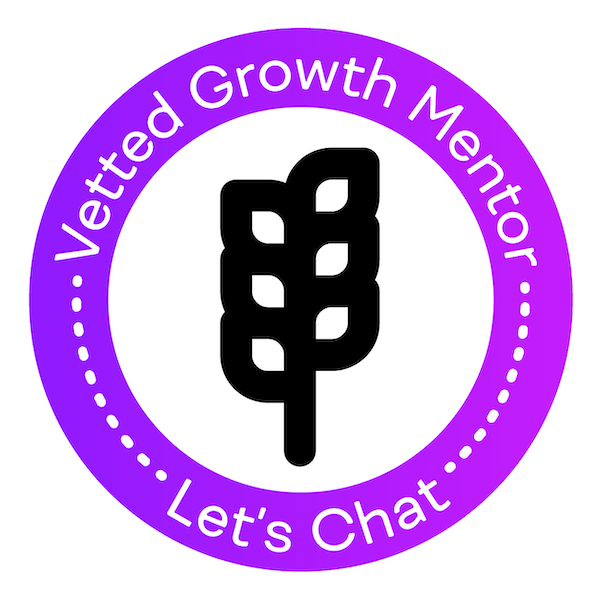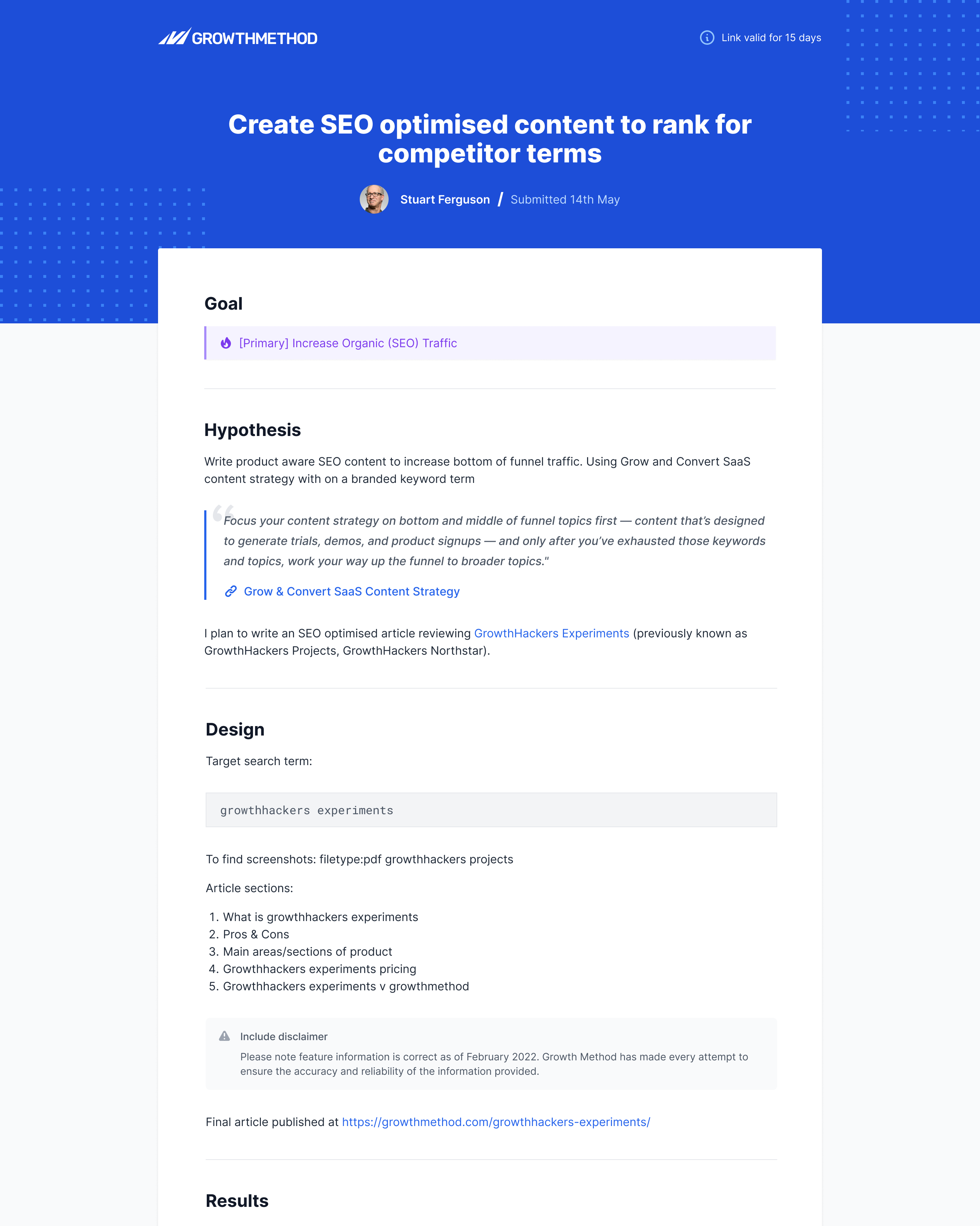Reforge Growth Series: Retention & Engagement
Article originally published in February 2024 by Stuart Brameld. Most recent update in April 2024.
Request a demo
Project management for growth and agile marketing professionals. Map your acquisition funnel, integrate analytics and run agile experiments.
Experiment results
Recent experiments results include competitor SEO, AI-driven content, exit-intent modals and AB testing homepage headlines.
Case study
"We are on-track to deliver a 43% increase in inbound leads this year. There is no doubt the adoption of Growth Method is the primary driver behind these results."
![]()
Certified
We are vetted mentors with Growth Mentor and a partner with the Agile Marketing Alliance.
The article provides our notes from the excellent Growth Series Course on Reforge.
Module 1: Growth Wins
Why growth wins
| Defensibility | Defensibility means the more distribution you have, the more you can leverage it into other products to drive even more distribution. |
| Resources | The idea here is growth attracts resources, which produces more growth. |
| Learning | The third reason growth wins is learning. Growth produces quicker and deeper learnings, which produces more growth. |
| Growth leads to more growth | One of the key concepts we will talk a lot about in the Reforge Growth Series is how the conventional wisdom of using funnels to think through growth is flat out wrong. |
The distribution challenge
Whilst in the past you could get noticed and be successful with great technology, or great product, today it’s not enough and companies also need great distribution in order to be successful.
- 1990s – Great tech = Success
- Mid 2000s – Great tech + Great product = Success
- Today – Great tech + Great product + Great distribution = Success
- As technology risk decreases, distribution risk increases
“Poor distribution, not product, is the number one cause of failure”
Peter Thiel, Facebook & PayPal (Zero to One)
Loops not funnels
The fastest growing companies are built on loops, not funnels. A loop being where an output is reinvested back into an input. Just like in finance where your return is a function of the principal you have invested, in growth loops the “return” is typically a function of the existing user base.
Growth is feedback loop in and of itself, the more we learning, the higher our hit rate on experiments – we can increase our batting average.
More growth (1) ….. leads to more data and users (2) ….. which leads to more experiments and feedback (3) ….. which leads to more and faster learnings (4) …. which leads to more growth (1) etc
The game has changed
| Change | Detail |
|---|---|
| Distribution is more competitive and expensive | Acquisition costs through content marketing, facebook ads, organic search click-through rates increasing dramatically. Overall CAC up around 50% according to Profitwell. Consolidation + tightening control + more competition. |
| The lifecycle of channels and tactics has accelerated | Every tactic goes through a lifecycle where effectiveness decreases over time (see viral channel effectives, Jamies Currier). Lifecycles are accelerating due to competition. |
| Access to data has increased as costs have decreased | Analytics software ecosystem has grown exponentially. Increased accessibility, more personalisation, machine learning. |
| The lines of product, marketing, engineering & sales have blurred | All play a role in influencing and enabling growth loop. Product, tech, data and design play much larger roles in acquisition and retention. No longer silo’d teams. |
Building a system
Building a strong growth system:
- Systematic – not throwing stuff at the wall
- Deterministic – not based on luck or randomess
- Sustainable – sustainable over time
- Repeatable – can repeat the system to adapt to the constantly changing environment
Growth output = Acquisition, Monetisation and Retention & Engagement. The growth process = growth model + experiments + user psychology.
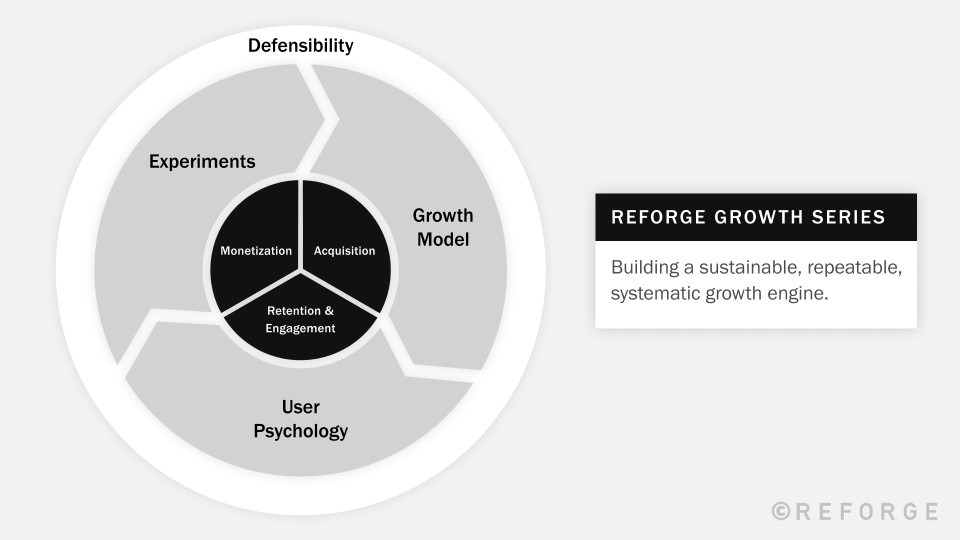
The goal is the drive towards the truth and remove human biases from the equation.
Module 2: Retention
Retention is the core of the growth engine
Retention is the core of the growth engine, it powers acquisition and monetisation, not the other way around.
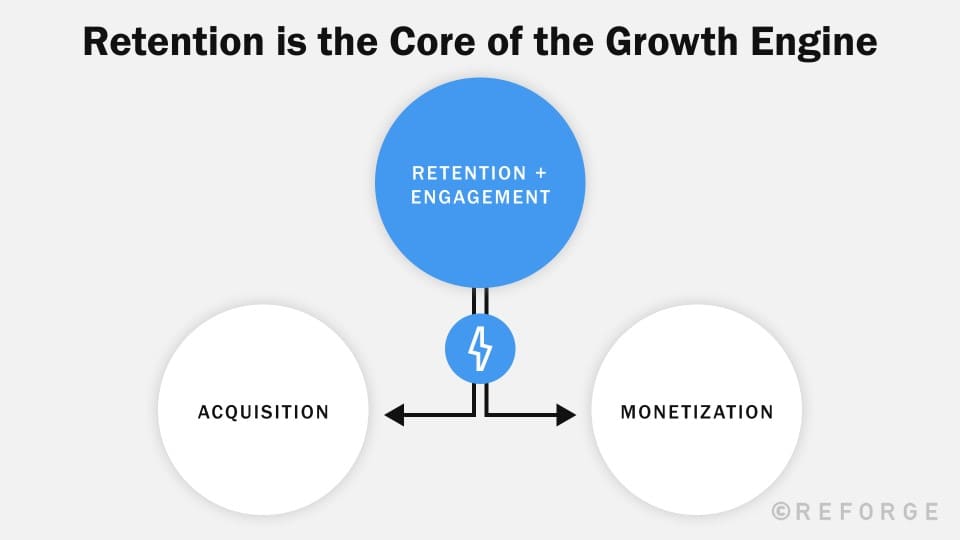
Increases in retention and engagement improve the rest of the growth model.
Retention & engagement separates the top 1% of companies from the rest – this applies across the best social networking companies (Facebook lead with 92% retention with largest market cap), B2C subscription (Spotify lead with 80% retention and largest market cap) and B2C subscription boxes (Stitch fix retention of 80% and largest market cap). Also applies to B2B SaaS companies (see analysis from Tomasz Tunguz).
How does retention powers acquisition and engagment?
- Drives acquisition loops – The longer you retain a user, the more opportunities you have to engage that user in a viral acquisition loop (e.g. viral invite loop, user generated content loop, paid marketing loop, sales loop)
- Builds competitive muscle – Afford higher customer acqusition costs – can raise cost of customer acquisition cost – increase bits or afford new channels that were previously too expensive
- Accelerates payback period – cohort will retirn CAC cost faster, so can reinvest at a faster pace. get more money back a faster pace which can then be used for acqusition.
How does retention power monetisation?
- Longer retention leads to more monetisation touchpoints – more ad inventory, more subscribers, more transactions, more upgrades etc
- Engagement correlates with longer retention – as engagement increases results in longer retention and more monetisation touchpoints
- Increase engagement drives monetisation models – deeper engagement despite user base, as well as ability to trigger a new pricing tier (more money per month)
Why retention can be the silent killer
Companies such as Homejoy, Fab, BranchOut and viddy had incredibly strong growth but ultimately failed as businesses due to do the retention “silent killer”.
Why is retention the silent killer?
- Retention requires a long-term view to understand the impact, which is a challenge in companies that prioritise short-term goals.
- Easy to cover-up with the wrong metrics e.g. top-line numbers like monthly active users
- Can assume good retention (breadth) without the required engagement (depth)
Retention is the output
How many users remained active within a defined time period after signing up?
Brian Balfour, Reforge
Retention is the output, so we need to improve the inputs of Activation, Engagement and Resurrection. The first step therefore is to clearly define this retention metric.
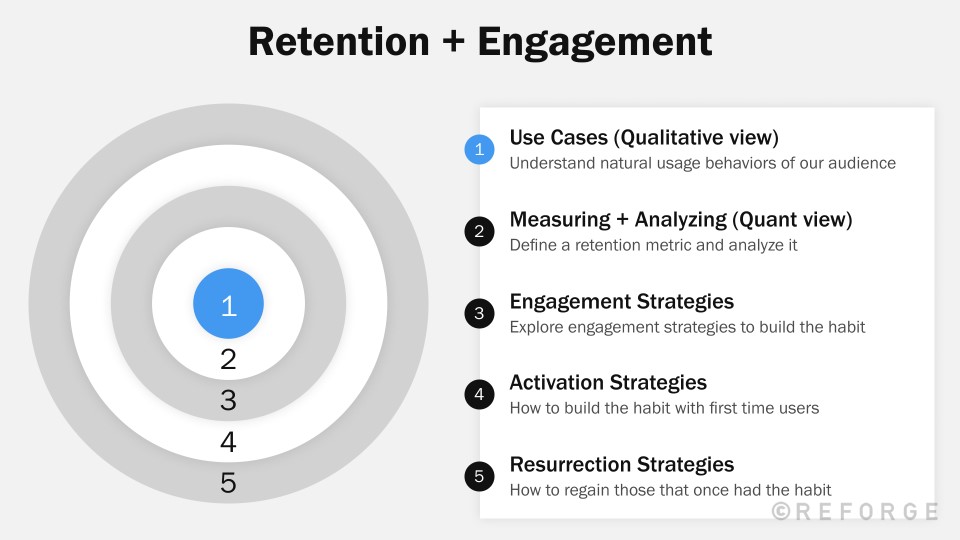
Nurture v nature component
- What is the natural usage behaviour and pattern around your product?
- Nurture should amplify and encourage the natural behaviour, but must be aligned
- The goldilocks point : too much feels spammy, too little and users forget about your product
The use case map (Qualitative)
The use case map is used to define the nature components as these inform our activation, engagement, retention and resurrection strategies.
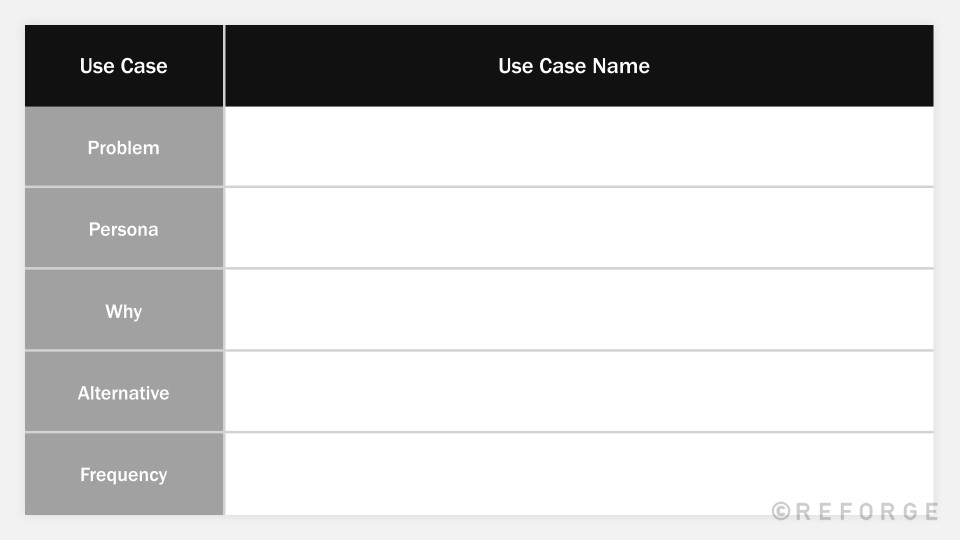
- Problem – definition of the problem in the words of our users
- Persona – who has this problem?
- Why – why people choose your product to solve that problem?
- Alternative – what is the alternative to solving the problem? (not necessarily direct competitors)
- Frequency – how often do they encounter the problem (use the alternative)?
When considering multiple use cases these use cases will be very different so retention metrics will likely also differ. This can be simplified by focusing on the dominant use-case to start.
Measuring & analysing retention (Quantitative)
In order to define a good retention metric need to validate qualitative assumptions from the use-case map with quantitative data.
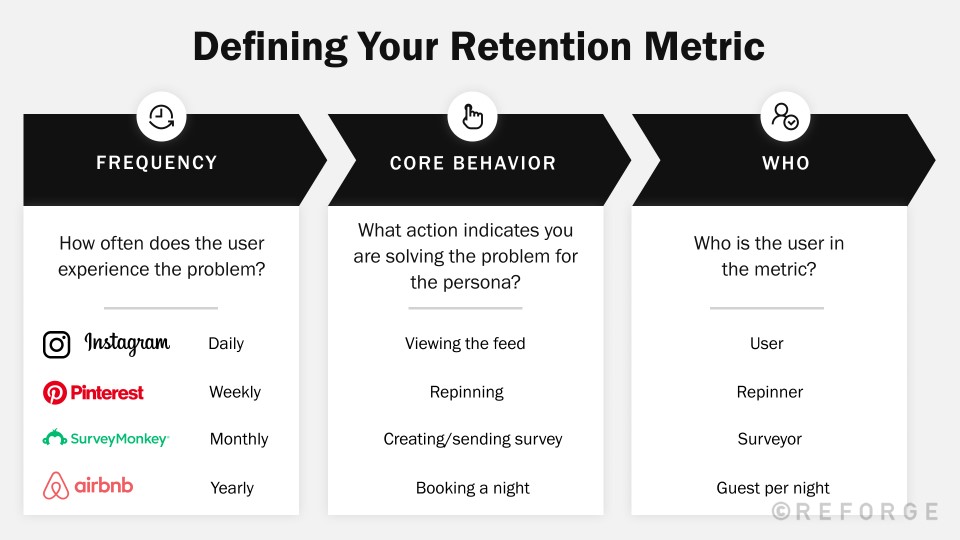
Aim to validate natural frequency, core behaviour and who:
- Frequency – analyse active users in the last 28 days
- Core behaviour – understand which actions indicates value delivery to the user and analyse e.g. sending survey once every 28 days
- Who – provide clarity around the user and core action
3 mistakes to avoid when defining a good retention metric:
- Align with the natural frequency of the use case
- Keep things simple, avoid combining multiple actions into a simple metric
- Avoid using revenue, this is the output, not the input (retention)
The key to analysing retention is through cohorts with a predefined timeframe (one week, or one month etc) to answer questions such as ‘How many users are still left after X time? ‘ and ‘What % of users go dormant after X time?’. This data can then be visualised with retention curves to make them easier to understand retention over time.
Module 2: Engagement
Retention = Were they active or not within the time period? Engagement – How active were they? Engagement = bait has been established.
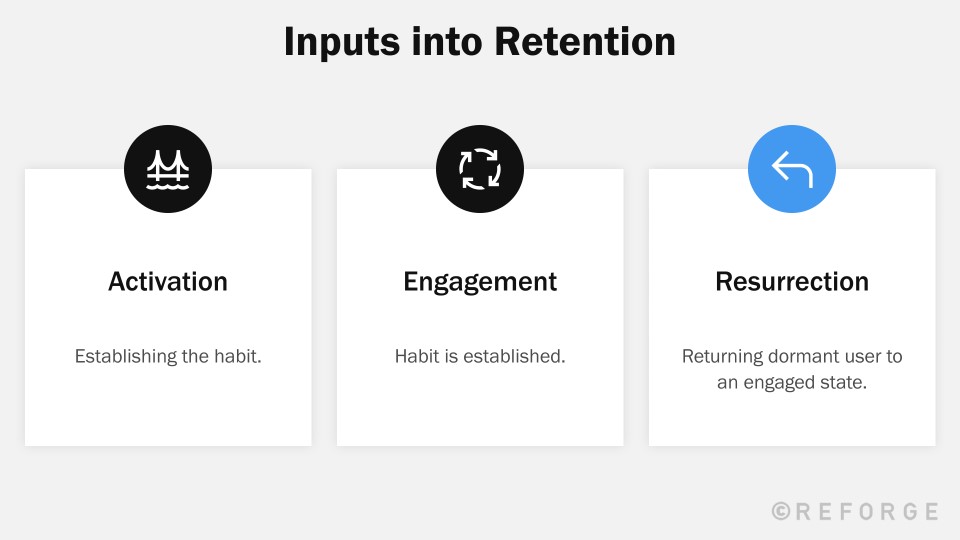
Building Habits
When we define a user as ‘Engaged’ this really means that a habit has been established with the product. Lots of research on habit building:
- Scientific Advertising, Claude Hopkins: Routine -> Reward -> Queue
- Hooked, Nir Eyal
- The Power of Habit, Charles Duhigg
The goal is to establish an organic habit loop with your users
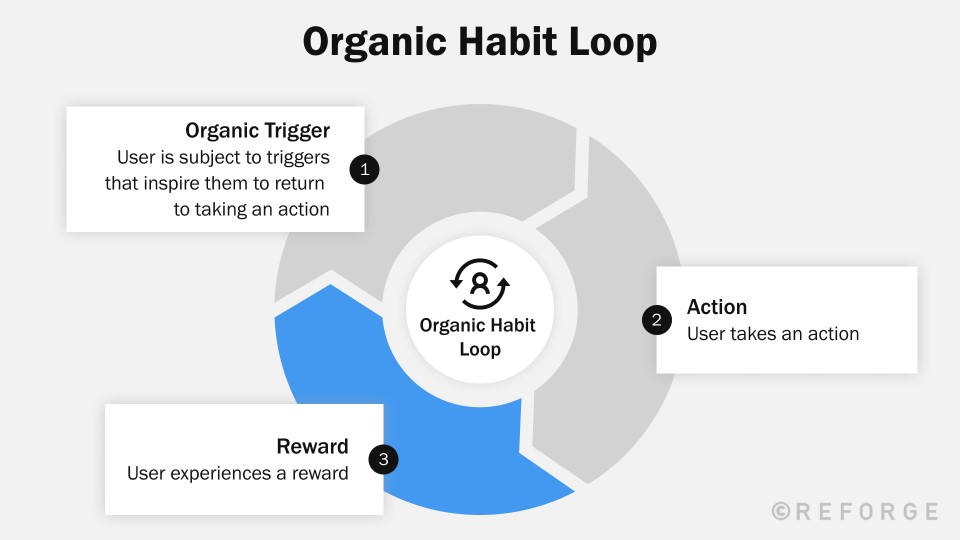
There are two main ways to reinforce habits as below, note environment loops are typically more expensive and add additional friction:
- Manufactured loops – push a manufactured trigger
- Types of trigger: Time trigger, Location trigger, Change trigger, Network (peer based) trigger and Programmatic triggers
- Channels: Email, Mobile, In Product, Platform, Browser, Desktop, Paid Media, Direct Mail
- Environment loops – insert into the natural environment surrounding the trigger
- Research – what are the places, products and people a user might touch?
- Build/Buy/Partner – what are the opportunities to solve?
- Costs
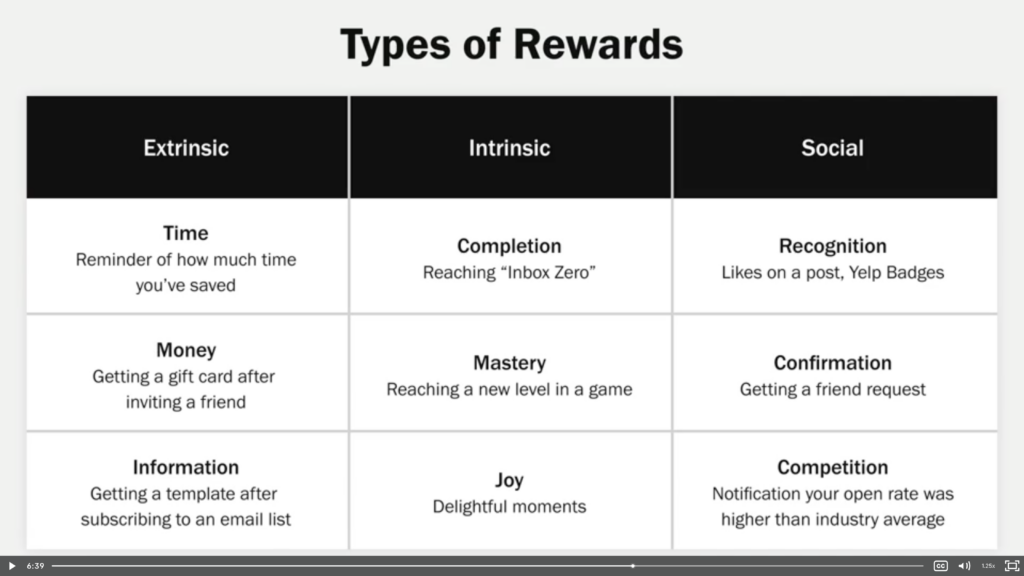
Your core organic habit loop can be added to and improved further with smaller supplemental loops over time.

Activation
Engagement – when the user has the habit established, Activation is about getting the user to establish that habit for the first time.
- Activation bridges the (often huge) gap between your marketing and your product
- Activation touches 100% of acquired users
- “Your first impressions is your last impression” – where the first impression is formed
- Activation influences (and improves) the first part of the retention curve (which in turn influences and improves acquisition, monetisation and virality)
- Activation is typically the highest impact on improving retention
- Activation is around establishing a habit
After all the testing, all the iterating, all this stuff, you know what the single biggest thing we realised was? Get any individual to seven friends in 10 days. That was it”
Chamath Palihapitiya, Head of Growth at Facebook

The habit moment
- Habits vary depending on the behaviour you are trying to establish the habit around e.g. drinking a glass of water per day is much easier that 50 sit-ups a day.
- On average it takes 66 days to build a new habit
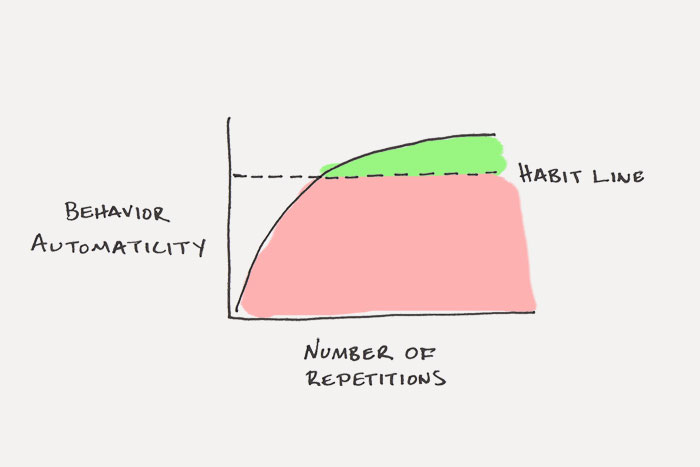
What does an engaged user in your app look like? Work back from frequency and retention metric above.
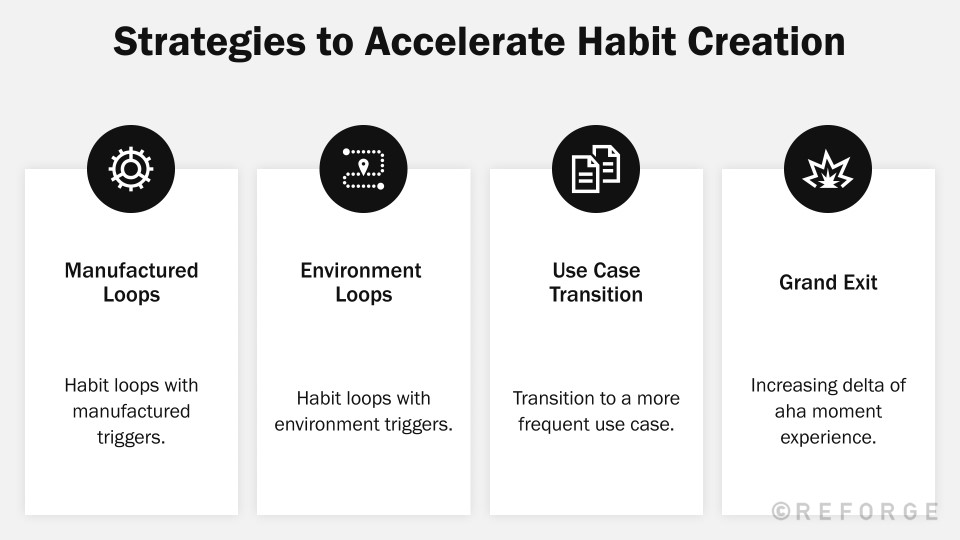
- Manufactured loops – design activation experience to take from signup into manufactured habit loop
- Environment loops – design activation experience to take from signup into environment habit loop
- Use case transition – can’t use manufactured or environment loops for low natural frequency products hence shift to a related more frequent organic trigger (note this can be expensive)
- Grand exit – last resort option but requires creating a 10X experience and reward e.g. early days of Uber
The aha moment
The journey of activation ends with the habit moment. The aha moment is when the user has experienced the core value proposition for the first time e.g.
- Pinterest – User has done the first pin within first 7 days
- HubSpot – User has seen their first tracked notification within the first day

[Click here to view notes for Growth Method]
- Core action = complete a successful experiment that can be shared
- Warm start = starting he first experiment using a template from the gallery
- Supporting actions = search functionality + ‘create growth idea’ button
- Empty states = block dashboard & reporting and prompt core action (e.g. modal text ‘You will see your reports and performance here’, modal button ‘Create a growth idea!’)
Setup moment
The journey of activation ends with the habit moment. The aha moment is when the user has experienced the core value proposition for the first time. The setup moment is when the user has done the must-haves to experience the aha moment and get to the habit moment.
- Pinterest – The user has chosen 5 topics of interest within the first day
- HubSpot – the user has installed the extension and tracked at least 3 emails

Have a checklist of must-haves as part of the setup experience e.g.
| Must have | Explanation | Examples |
|---|---|---|
| User information | Info about the user, company, credit card, location, preferences | Add your name and email, Select your topics of interest (e.g. Quora, Pinterest, Surveymonkey) |
| Permissions | Channel, location, or device permissions for loops and re-engagement | Add an integration (e.g. Google Analytics) |
| Social | To get value, do they need others in the experience? | People you may know, Invite your colleagues etc |
Notifications & incentives are a supporting strategy and shouldn’t be used alone. They are best used for dropout detection to bring back in to the app and complete activation.
Resurrection
Retention = (Activation, Engagement, Resurrection)
The goal of resurrection Dormant users – people that used to have the habit and have become unengaged at some point
Important:
How big is your pool or resurrectable users?
- Most users will likely never have activated (lost before the habit moment)
- Most companies have an activation problem, not a resurrection problem
- The probability of being able to ressurect a user decays quickly over time (and cost to resurrect them increases)
What is the real potential lift from contacting these users?
- No. of users x response rate x % retained = total lift from resurrection campaign
- Users – total pool is likely much smaller than you think
- Response rate – many are likely already tuned out (others wouldn’t be dormant)
- % Retained – even if you get them to response, what % will re-establish the habit
- However, we have nothing to lose
When is resurrection the right opportunity to focus on?
- After focusing on activation and engagement
- Understand the true opportunity and cost first
- Capitalise on high psych time periods for your audience when people might come back
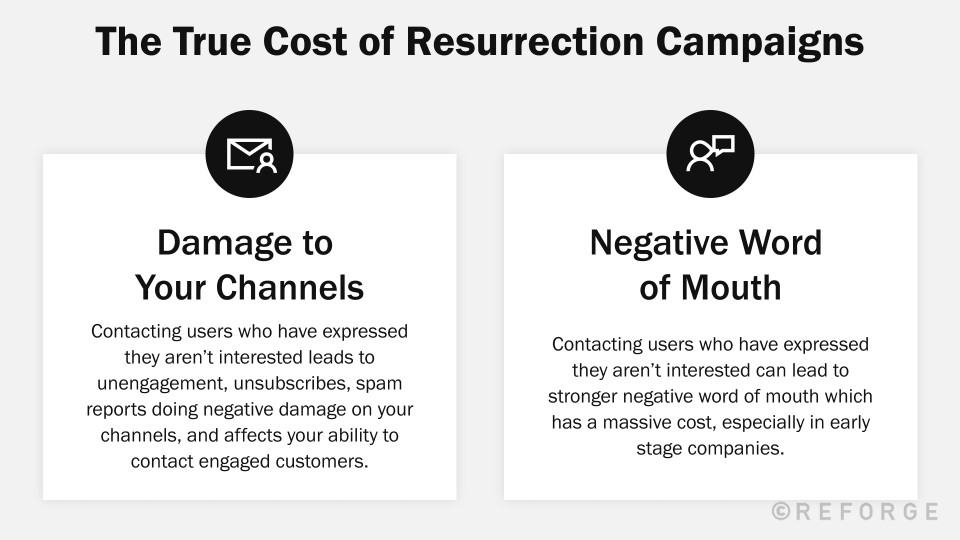
Involuntary dormant users
Users that disengage due to some reason that wasn’t a conscious choice. Involuntary dormant users are easier to resurrect than voluntary dormant users, hence start here.
- Product issue e.g. technical bug, logged out, switching devices etc
- Leaving e.g. left the company, market – particularly common in b2b
- Payment failure – expired credit cards, address changes etc
How to prevent:
- Persistent notifications – block usage until updates done
- Email notifications – make it simple to update the required information
- Payment strategies – optimise options, re-try, auto-update credit cards etc
Voluntary dormant users
Users that have made a conscious choice not to engage in the product anymore. May not have been using the product, ignoring notifications and likely formed an opinion on why they don’t need the product.
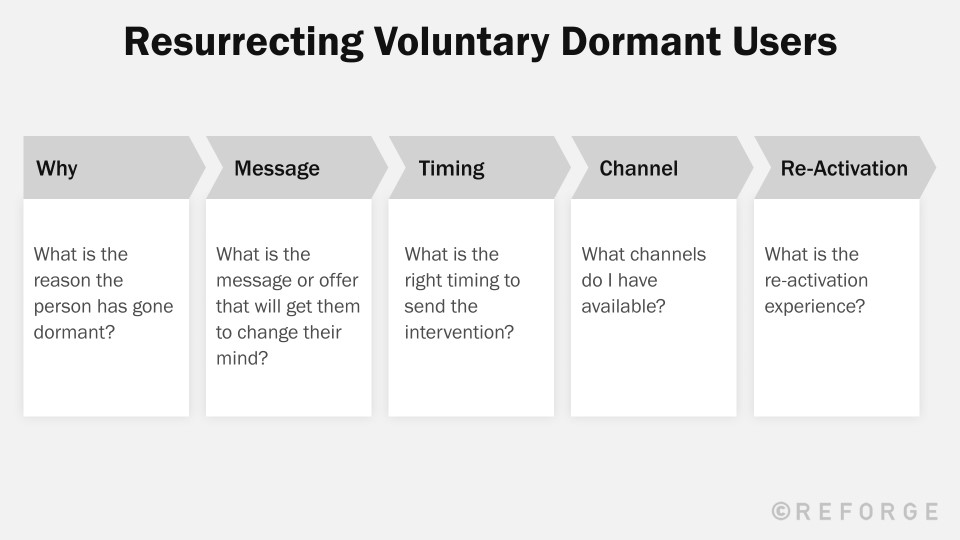
Module 3: Activation
Coming soon ……
